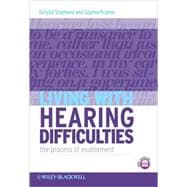
What is included with this book?
Sophia E. Kramer, PhD, is Senior Researcher and Psychologist at the Department of E.N.T. / Audiology / EMGO Institute for Health and Care Research at the VU University Medical Centre in Amsterdam, the Netherlands.
| Foreword | p. viii |
| Preface | p. x |
| Acknowledgements | p. xiii |
| Introduction | p. 1 |
| The need for this book | p. 1 |
| Terminology | p. 2 |
| Layout of the book | p. 4 |
| The World Health Organization classifications | p. 5 |
| Theoretical/management models in the general rehabilitation literature | p. 8 |
| Models of audiological enablement | p. 11 |
| The Goldstein-Stephens model | p. 13 |
| The role of positive experiences associated with hearing impairment | p. 19 |
| Relevant measures in assessing patients' needs and the outcomes of interventions | p. 21 |
| Development of a preliminary model appropriate to hearing impairment | p. 24 |
| Conclusion | p. 25 |
| Seeking help | p. 26 |
| Introduction | p. 26 |
| Becoming aware of hearing difficulties | p. 27 |
| The decision to seek help | p. 31 |
| Referral for hearing help | p. 36 |
| Ethics/philosophy of adult screening | p. 38 |
| Conclusion | p. 42 |
| Types of hearing impairment and their consequences | p. 43 |
| Introduction | p. 43 |
| Basic anatomy and physiology and their implications | p. 43 |
| Purposes and process of assessment | p. 47 |
| Types of hearing impairment and their consequences | p. 50 |
| Severity of hearing impairment | p. 54 |
| Unilateral/asymmetrical hearing impairment | p. 55 |
| Age of onset | p. 55 |
| Genetic issues | p. 57 |
| Progressive/sudden onset | p. 58 |
| Conclusion | p. 58 |
| The influence of other factors on assessment and goals of enablement | p. 60 |
| Introduction | p. 60 |
| Auditory symptoms | p. 60 |
| General aural symptoms | p. 63 |
| Vision | p. 66 |
| Cognitive and intellectual factors | p. 67 |
| Neuromusculoskeletal problems | p. 68 |
| Conclusion | p. 69 |
| Communication | p. 71 |
| Introduction | p. 71 |
| Ecological audiology | p. 71 |
| Ramsdell's classification | p. 73 |
| Attitudes of the Deaf | p. 81 |
| Conclusion | p. 82 |
| Social and emotional aspects of hearing impairment | p. 83 |
| Introduction | p. 83 |
| Participation in life | p. 83 |
| Psychosocial dysfunction | p. 84 |
| Psychosocial consequences of Deafness | p. 90 |
| Demographic factors | p. 91 |
| Conclusion | p. 94 |
| Hearing impairment in the family | p. 96 |
| Introduction | p. 96 |
| Impact of hearing impairment on significant others | p. 96 |
| Coping strategies | p. 98 |
| Inclusion of significant others in enablement programmes | p. 100 |
| Hearing impairment arising from genetic causes or with a familial basis | p. 100 |
| Impact of having a family history of hearing impairment | p. 102 |
| Discussion | p. 107 |
| Conclusion | p. 108 |
| The process of enablement at work | p. 109 |
| Introduction | p. 109 |
| Statistics | p. 109 |
| Impact of hearing impairment on occupational performance | p. 110 |
| Impact of work-related hearing impairment on significant others | p. 113 |
| Vocational enablement | p. 114 |
| Vocational Enablement Protocol (VEP) | p. 115 |
| Discussion | p. 120 |
| Conclusion | p. 121 |
| Leisure and the wider social environment | p. 122 |
| Introduction | p. 122 |
| Prevalence | p. 122 |
| Solitary versus interactive pastimes | p. 123 |
| The role of leisure | p. 123 |
| Opportunities for entertainment and leisure | p. 124 |
| Community life | p. 125 |
| Recreation and leisure | p. 126 |
| Religion and spirituality | p. 131 |
| Human rights, political life and citizenship | p. 132 |
| Conclusion | p. 133 |
| The process of enablement 1: Evaluation and decision-making | p. 134 |
| Introduction | p. 134 |
| The evaluation process | p. 134 |
| Integration and decision-making | p. 156 |
| Conclusion | p. 159 |
| The process of enablement 2: Short-term remediation | p. 160 |
| Introduction | p. 160 |
| Instrumentation | p. 160 |
| Strategy | p. 174 |
| Ancillary help | p. 178 |
| Conclusion | p. 180 |
| Enablement 3: Ongoing remediation and outcome assessment | p. 181 |
| Ongoing remediation | p. 181 |
| Effectiveness of group programmes | p. 194 |
| Outcome assessment | p. 196 |
| Conclusion | p. 201 |
| Overall conclusions | p. 202 |
| Appendix: Longitudinal changes in enablement needs of older people with hearing impairment | p. 205 |
| References | p. 209 |
| Index | p. 237 |
| Table of Contents provided by Ingram. All Rights Reserved. |
The New copy of this book will include any supplemental materials advertised. Please check the title of the book to determine if it should include any access cards, study guides, lab manuals, CDs, etc.
The Used, Rental and eBook copies of this book are not guaranteed to include any supplemental materials. Typically, only the book itself is included. This is true even if the title states it includes any access cards, study guides, lab manuals, CDs, etc.